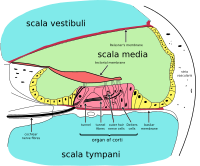
Photo from wikipedia
Simple Summary In this study, we developed a simple simulation model to illustrate the effects of different mating patterns on the spread of autosomal recessive deafness 1A (DFNB1A) in an… Click to show full abstract
Simple Summary In this study, we developed a simple simulation model to illustrate the effects of different mating patterns on the spread of autosomal recessive deafness 1A (DFNB1A) in an isolated human population with regard to the intensity of selection pressure. The modeling results have revealed that the prevalence of DFNB1A in an isolated population can be dramatically increased under frequent assortative marriages in a relatively short time period under the pressure of “relaxed” selection. However, under current conditions, the proportion of recessive homozygotes quickly reaches a short plateau and then continuously decreases. Moreover, in the long term, the studied effect can be leveled by growing social equality for deaf people, as evidenced by the results of neutral selection modeling. Abstract An increase in the prevalence of autosomal recessive deafness 1A (DFNB1A) in populations of European descent was shown to be promoted by assortative marriages among deaf people. Assortative marriages became possible with the widespread introduction of sign language, resulting in increased genetic fitness of deaf individuals and, thereby, relaxing selection against deafness. However, the effect of this phenomenon was not previously studied in populations with different genetic structures. We developed an agent-based computer model for the analysis of the spread of DFNB1A. Using this model, we tested the impact of different intensities of selection pressure against deafness in an isolated human population over 400 years. Modeling of the “purifying” selection pressure on deafness (“No deaf mating” scenario) resulted in a decrease in the proportion of deaf individuals and the pathogenic allele frequency. Modeling of the “relaxed” selection (“Assortative mating” scenario) resulted in an increase in the proportion of deaf individuals in the first four generations, which then quickly plateaued with a subsequent decline and a decrease in the pathogenic allele frequency. The results of neutral selection pressure modeling (“Random mating” scenario) showed no significant changes in the proportion of deaf individuals or the pathogenic allele frequency after 400 years.
Journal Title: Biology
Year Published: 2022
Link to full text (if available)
Share on Social Media: Sign Up to like & get
recommendations!